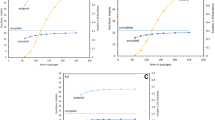Abstract.
The question whether the noncoding DNA strand had or still has the capability for encoding functional polypeptides has been addressed in several articles. The theoretical background of the views advocating this idea arose from two groups of findings. One of them was based on various observations implying that the genetic code was adapted for double-strand coding. The other group of theories arose from the observation of gene-length overlapping open reading frames (O-ORFs) on the antisense DNA strand in a number of genes. In fact, the above theories, which I term selectionist, conceive a novel conception of gene evolution, proposing that new genes can be created by the utilization of antisense DNA strand. In contrast, neutralist theory claims that the O-ORFs are mere by-products of evolutionary processes acting to create special codon usage and base distribution patterns in the coding sequences.
Similar content being viewed by others
Author information
Authors and Affiliations
Additional information
Received: 16 June 2000 / Accepted: 31 August 2000
Rights and permissions
About this article
Cite this article
Boldogköirid, Z. Coding in the Noncoding DNA Strand: A Novel Mechanism of Gene Evolution?. J Mol Evol 51, 600–606 (2000). https://doi.org/10.1007/s002390010123
Published:
Issue Date:
DOI: https://doi.org/10.1007/s002390010123




